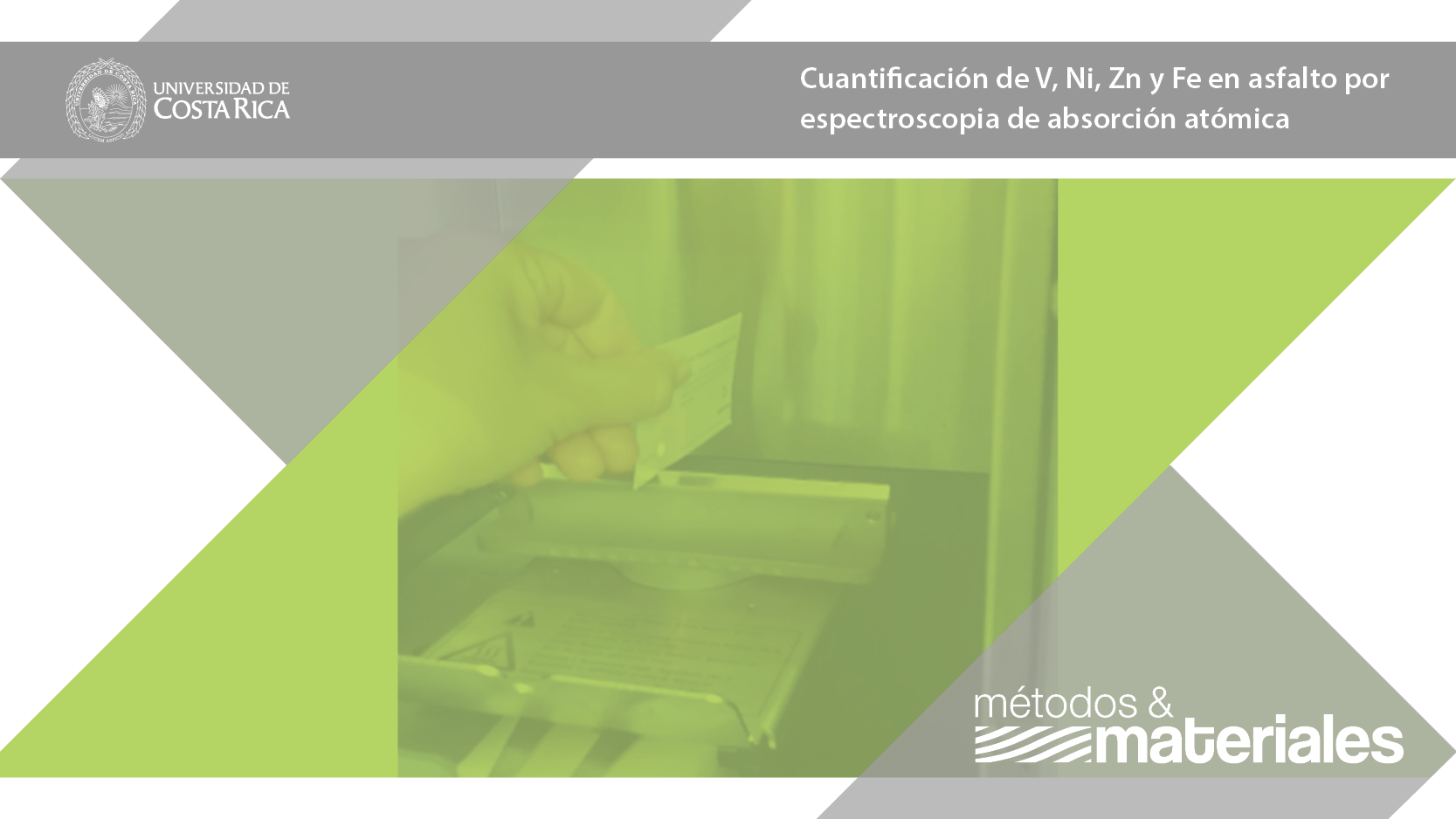Abstract
Asphalt has complex chemical and physical compositions that normally vary with the source of crude oil. Its composition is based on approximately 84% C, 10% H2, 1% O2 and 5% trace elements such as S, Ni, V and Fe. This is the development of a new method to quantify V, Ni, Zn and Fe on asphalt AC-30 by atomic absorption spectroscopy. These metals were detected qualitatively with a higher intensity in an X-ray analysis by fluorescence in an electron scanning microscope. Some metals found in asphalt may have a catalytic effect on the oxidation of asphalt.The research proposes a treatment process of up to 2 g of asphalt, which is based on dilution with mineral spirits in volumetric flasks with the aid of an ultrasonic bath to lighten the dilution. The parameters of optimization of the method are dictated by looking for the adequate instrumental data in the atomic absorption equipment to obtain the highest possible absorbance in the alignment of both the burner and the hollow cathode and deuterium lamps; In addition to the optimization of the flame and the flow of the nebulizer. The calibration curves of each metal were performed with a hydrocarbon-based standard to measure metal concentrations in asphalt in mg / kg with a linear correlation coefficient of at least 0,995. The asphalt recovery study is performed with the addition of a quantity of the metals directly to the asphalt matrix aliquots. The concentrations obtained for Ni were 70, V 330, Zn 24 and for Fe 10 ppm, which presented a relative standard deviation of less than 1%, indicating that measurements of the same sample are accurate and have little dispersion between them. The average recoveries were 99,17% for Ni, 100,30% V, 92,26% Zn and 97,72% Fe. These results indicate that the method is reliable for the quantification of metals by the atomic absorption technique; values greater than 100% are given by readings of absorbances higher than expected or by generation of false positives in the technique.
References
Agilent Technologies Inc. (2013). Agilent 240/280 Series AA (including Zeeman). 13ra ed. Malasia: Autor.
Agilent Technologies Inc. (2015). Flame Atomic Absorption Spectrometry. Analytical Methods. 13th Ed. Australia Autor. American Standard for Testing and Materials. ASTM D5/D5M. (2013). Standard Test Method for Penetration of Bituminous Materials. 4 páginas. Estados Unidos.
Aurora Instruments Ltd. (2015). Preparation of Petrochemical Samples for Atomic Absorption Spectrometric Analysis. Canadá.
Bishara, S. (1997). New, simple, rapid, and precise method for trace analysis of nickel and vanadium in petroleum asphalt. Transportation Research Record: Journal of the Transportation Research Board, (1586), 40-49.
Branthaver, J., Nazir, M., Petersen, J., Dorrence, S. y Ryan, M. (1984). The effect of mattalo porhyrins on asphalt oxidation. II. The effect of vanadylchelates found in petroleum. Liquid Fuels Technology, 2(1), 67-89.
Cárdenas, J. y Fonseca, E. (2009). Modelación del comportamiento reológico de asfalto convencional y modificado con polímero reciclado, estudiada desde la relación viscosidad-temperatura. Revista EIA, 12(2), 125-137.
Cortés, H. (2012). Análisis del proceso de oxidación del asfalto colombiano 80/100 en inmersión bajo agua periodo 12-21 meses. Magister en Ingeniería Civil. Pontificia Universidad Javeriana
Fonseca, E. (2015). Aplicación de un método espectrofotométrico de absorción atómica para el análisis de hierro, calcio, magnesio, potasio, y sodio en cemento portland. Licenciado en Ciencias Químicas, con mención en Química Analítica. Pontificia Universidad Católica del Ecuador.
Gallego, A.; Garcinuño, R. y Morcillo, M. (2013). Experimentación en química analítica. Madrid Universidad Nacional de Educación a Distancia.
García, D. y Melgar G. (2011). Validación del método espectrofotométrico (3500-fe D) de la fenantrolina para determinación de hierro total en agua potable. Tesis de Licenciatura en Química y Farmacia. Universidad de El Salvador.
Harvey, D. (2000). Atomic Absorption Spectroscopy. En Modern Analytical Chemistry (pp. 412-422). USA McGraw-Hill Higher Education.
Nahar, S., Schmets, A., Scarpas, A. y Schmets, A. (2015). Determining Trace Elements in Bitumen by Neutron Activation Analysis. In Transportation Research Board 4th Annual Meeting (No. 15-0321).
Pascual, J., Hechavarría, J., de Zayas, M., Ferrer, O., Dennes, E. y Álvarez, O. (2006). Determinación de vanadio por espectrometría de absorción atómica en fuel oils. Revista CENIC Ciencias Químicas, 37(1), 8-10.doi ISSN 1015-8553
Perkin Elmer. (2013). Atomic spectroscopy - A guide to selecting the appropriate technique and system. USA: Autor.
Ramadan, N. (2011). Sample preparation for flame atomic absorption spectroscopy anverview. Rasāyan. 4(1), 49-55.doi ISSN 0974-1496
Razmilic, B. (1994). Espectroscopia de absorción atómica. En Control de calidad de insumos y dietas acuícolas. México Merck Química Chilena.
Robertson, R., Branthaver, J., Plancher, H., Duvall, J., Ensley, E., Harnsberger, P. y Petersen, J. (1991). Chemical properties of asphalts and their relationship to pavement performance (No. SHRP-A/UWP-91-510). Washington, DC Strategic Highway Research Program, National Research Council.
Rubinson, K y Rubinson, J. (2001). Análisis Instrumental. Madrid Pearson Educación.
Skoog, D.; Holler, F y Nieman, T. (2001). Principios de Análisis Instrumental. España McGraw-Hill.5ta Ed.
Speight, J. (2014). The chemistry and technology of petroleum. USA CRC press.
Speight, J. (2016). Asphalt. Materials Science and Technology. USA Butterworth-Heinemann.
Vaca, R. (2013). Validación del método analítico para la determinación de arsénico, mercurio y selenio por espectroscopia de absorción atómica con un sistema de generación de hidruros, en lixiviados con fines de acreditación en el laboratorio de Química Ambiental del OSP. Químico de alimentos. Universidad Central del Ecuador.
Varian Australia Pty. (2000). Atomic Spectroscop y Publications. [CD]. Versión 1.0.
Vega, A y Vélez, P. (2011). Validación del método de determinación de cobre y zinc por espectroscopia de absorción atómica de llama en agua cruda y tratada para el laboratorio de análisis de aguas y alimentos de la Universidad Tecnológica de Pereira. Tecnólogo en Química. Universidad Tecnológica de Pereira.






